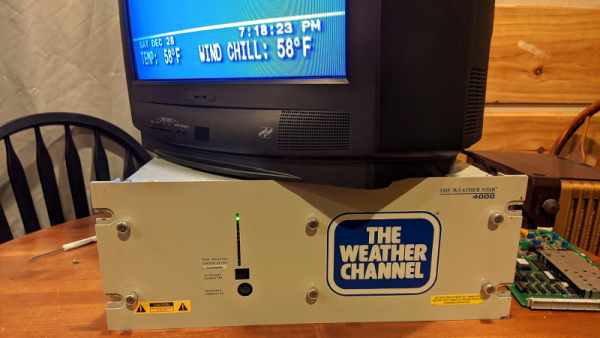For American readers of a certain age, Local on the 8s likely holds a special spot in your heart. The program, once a staple of The Weather Channel, would provide viewers with a text and eventually graphical depiction of their local forecast set to some of the greatest smooth jazz ever heard outside of an elevator. In the days before smartphones, or even regular Internet access for that matter, these broadcasts were a critical part of planning your day in the 1980s through to the early 2000s.

Up until recently the technical details behind these iconic weather reports were largely unknown, but thanks to the Herculean efforts of [techknight], the fascinating engineering that went into the WeatherSTAR 4000 machines that pumped out current conditions and Shakin’ The Shack from CATV distribution centers all over the US for decades is now being documented and preserved. The process of reversing the hardware and software has actually been going on for the last couple of years, but all those juicy details are now finally going to be available on the project’s Hackaday.IO page.
It all started around Christmas of 2018, when an eBay alert [techknight] had configured for the WeatherSTAR 4000 finally fired off. His offer was accepted, and soon he had the physical manifestation of Local on the 8s in his own hands. He’d reasoned that getting the Motorola MC68010 machine working would be like poking around in a retrocomputer, but it didn’t take long for him to realize he’d gotten himself into a much larger project than he could ever have imagined.
The trouble is that the WeatherSTAR 4000 was designed to get all its software as part of the satellite downlink that provided the actual weather data. The machine has no mass storage, so all of its software was stored in RAM. Once the box was switched off, all that precious code was lost forever.
find anyone who’d ever managed to capture the data stream going into one of these boxes, and as this generation of hardware hasn’t been used since 2014, it’s not as if he can break out an SDR and record it himself. To make a long story short: he was on his own.
What followed is easily some of the most impressive reverse engineering work we’ve ever seen. It took months of painstaking labor just to buzz out the boards and create new schematics, and after that he still had to wrap his head around the PALs and early FPGAs scattered throughout the machine without so much as a scrap of original documentation.
At the time of this writing, [techknight] is still writing up the earliest phases of the reverse engineering process with a new post or two each day on the project page. It’s going to be awhile before he covers everything, especially considering how deep he dives into each post, but we’re certainly not complaining. If you’d like to see his current process, he’s always showing the revived WeatherSTAR off on social media.
If you just wanted to relive those Local on the 8s memories, naturally you’d be better off with a Raspberry Pi and a bit of Python. But there’s something to be said for having the original hardware, and as he now has the distinction of owning what’s likely the only operational WeatherSTAR 4000 on the planet, we’re sure [techknight] doesn’t regret the time he poured into this incredible project.

